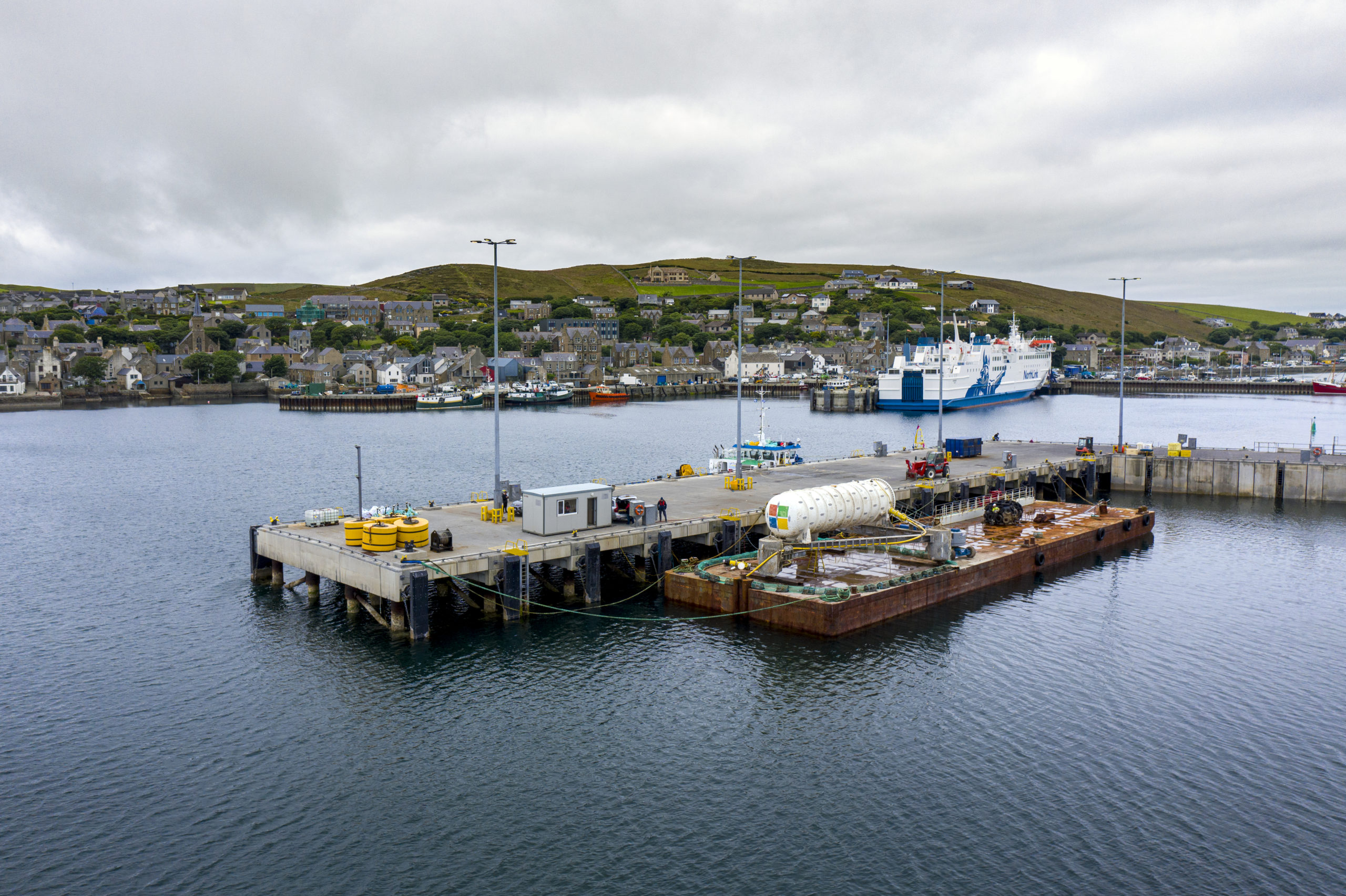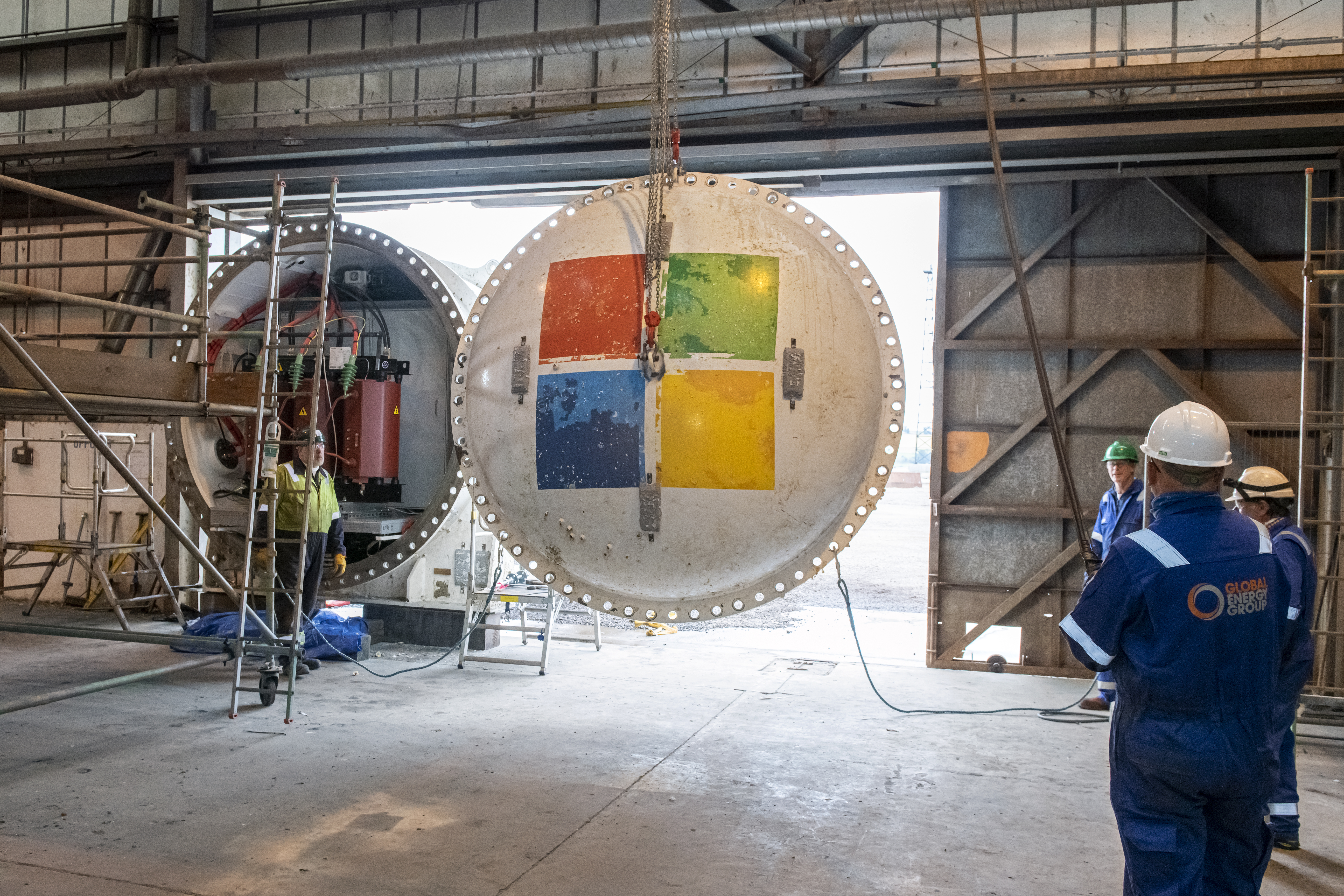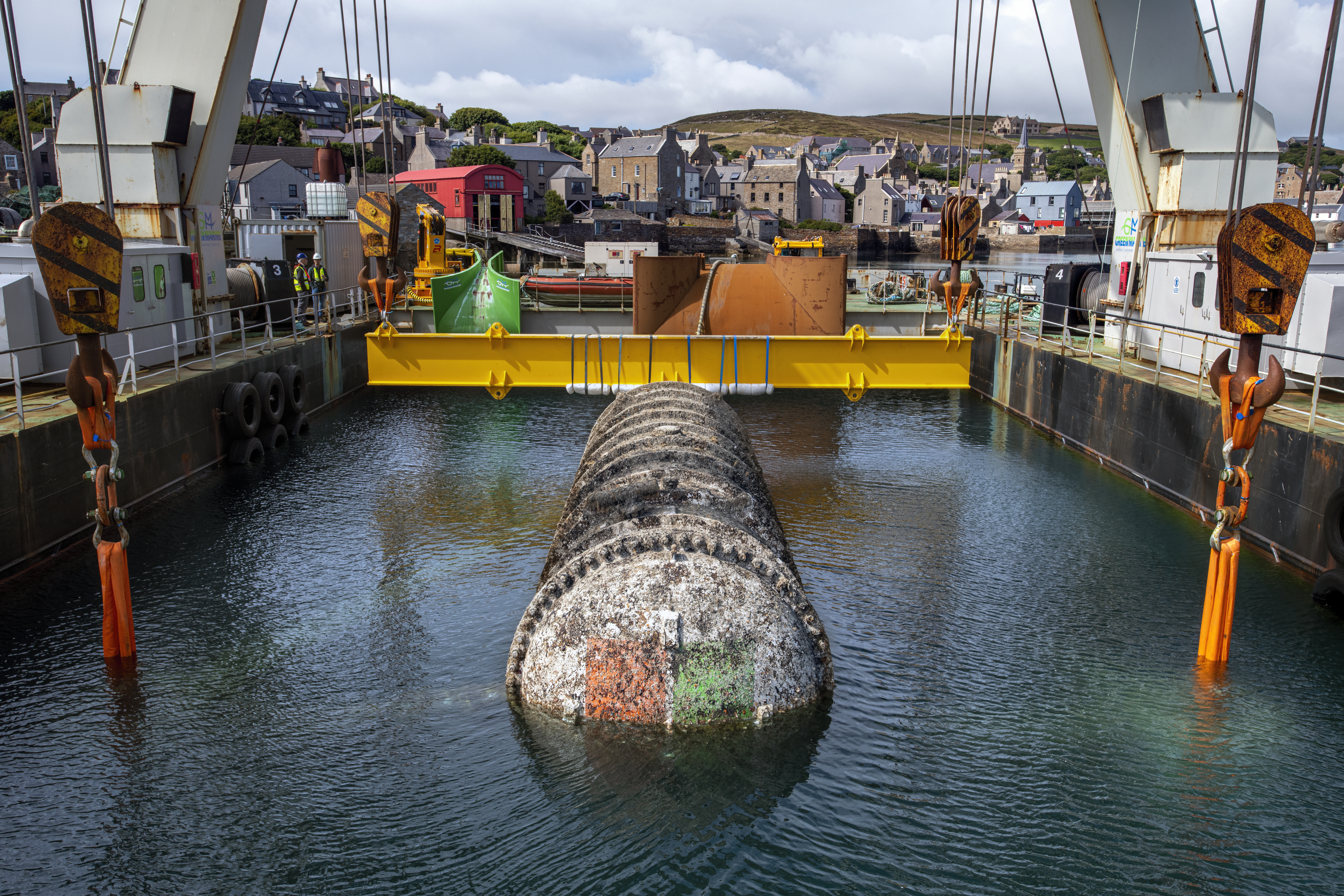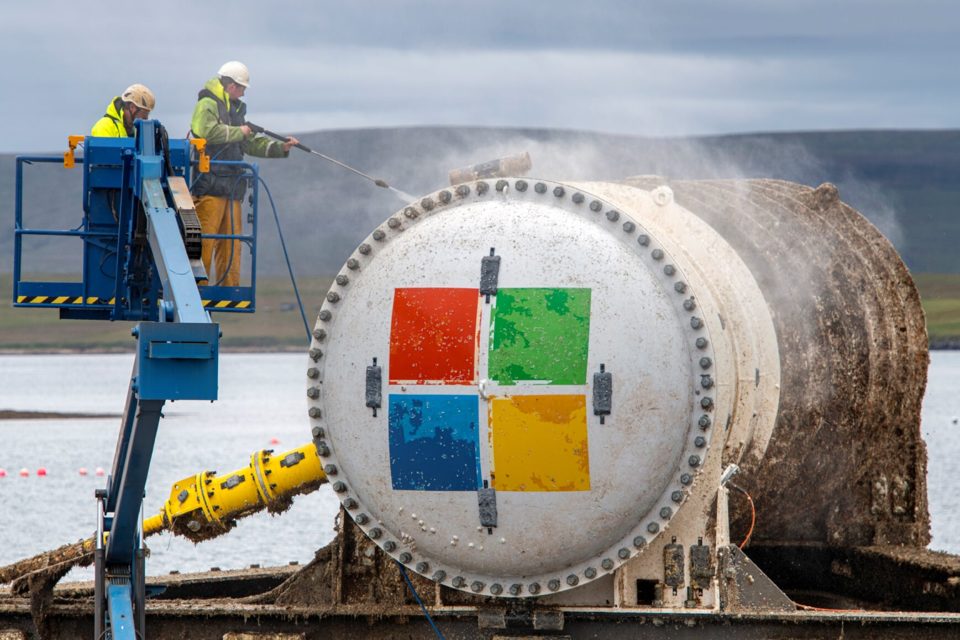Hello and welcome to Microsoft Stories, a new podcast about technology and innovation.
In this episode we are focusing on Project Natick, a Microsoft research project that placed data centres in the sea and powered them using renewable energy.
The aim is to see if data centres can be deployed closer to the people, businesses and organisations who use them. Almost half of the world’s population lives within 120 miles of the ocean, so the benefits for them are potentially huge.
How did Microsoft come up with the idea to place data centres in the sea, and how did it happen?
Ben Cutler, who leads the Project Natick team, and Michael Wignall, Azure Business Lead at Microsoft UK, will answer those questions in this podcast.
Click the play button and join us on our journey.
Click here to visit our Podcast page.
Transcript of this episode
MUSIC INTRO
Hi, I’m Andy Trotman, Head of News at Microsoft UK. Welcome to Microsoft Stories – a new podcast looking at technology and the people who use it.
In this series, I’m trying to answer the question: what is innovation? It means different things to different people. Innovation can be as simple as adding an eraser to the end of a pencil or as complex as sending people to the Moon.
What does it mean to be innovative? How do you know you’re being innovative? Along my journey, I meet people using technology in amazing ways, and discover what innovation means to them.
Join me on my journey.
SOUND OF SEAGULLS AND WAVES
The seas around Scotland are home to an incredible array of creatures. A third of the world’s grey seals live there, and it’s also home to the most northerly population of bottlenose dolphins, 23 of the world’s 82 species of whales and dolphins, and 43% of all seabirds breeding in the EU. During the summer it’s also common to spot basking sharks and the endangered leatherback turtle.
Beneath the surface, there are rocky reefs covered in corals, fans and sponges – and until recently there was also a data centre.
Off the coast of the Orkney Islands sits the European Marine Energy Centre, a test site for experimental tidal turbines and wave energy converters that generate electricity from the movement of sea water. It is here, that Microsoft carefully placed an underwater data centre in 2018. It stayed there for two years, before it was retrieved in the summer of 2020. The team overseeing Natick are now collating what they’ve learned.
It’s a project containing so much innovation that I barely know where to begin.
BEN: I’m Ben Cutler. I work in Microsoft Research in a group called special projects. And the mandate of this organisation basically is to look across the company and the things that we’re trying to achieve internally or for our customers and basically take big swings at large challenges that the company has.
Ben leads the Project Natick team, which lowered a 40-foot-long data centre into the sea. It contains 12 racks and 864 servers. That’s small compared with data centres on land, but this is a test to see if this could be a way for Microsoft to take the Azure cloud to more people in a more sustainable way.

Current datacentres, which are the backbone of the internet, require a lot of energy to run and cool. Think of what happens when your own laptop gets hot. Fans start to rotate and the hot air is pushed out of holes, so your computer stays cool and you can keep working and creating. Data centres on land work in a similar way but on a much larger scale.
By placing data centres in the ocean, they are naturally cooled by the sea water that surrounds them. It is a solution that’s much cheaper, quicker and easier to deploy. It’s also more environmentally friendly. A cable connects Project Natick to the Orkney Island grid, but it needs just a quarter of a megawatt of power when running at full capacity.
BEN: Project Natick is Microsoft’s exploration of underwater data centres. And we see this as a means to more rapidly deploy environmentally sustainable data centres close to our customers. So what that means is today if you look at data centres, it’s a challenge to build large data centres and do it quickly to respond to customer demand. And so we see data centres in this context as more of a manufactured item. So as opposed to a construction project, which is what data centres are today, imagine a factory where the data centre is constructed, it’s filled with servers, and much like the cell phone in your pocket, we can very rapidly deliver it and get it running.
Almost half of the world’s population lives within 120 miles of the ocean, so the benefits of Project Natick are obvious. Businesses could use more powerful Azure-based technologies to change how they work and help their staff be more innovative and creative.
Michael Wignall leads the Azure business for Microsoft in the UK. He told me that companies of all sizes are seeing the cloud as a crucial innovation tool that’s helping them compete.
MICHAEL: I think Azure is a core driver for innovation across customers in the UK big and small. Broadly, when we think about how customers use our platform, there’s two types of projects that they use it for. They’re either migrating existing things that they’re running today, that traditionally are probably on-premise or in private clouds, into the public clouds. So they’re migrating stuff that exists, or they’re using it for innovation. They’re creating something new. They’re delivering new capabilities that they didn’t previously have. And they’re doing that on our platform because it provides better capability, better features and functionality, better cost efficiency to allow them to innovate and develop new capabilities quicker.
SOUND OF A NOISY OFFICE
For many busy, small companies, just moving from storing data in their own servers to the cloud can be innovative. Being able to access their data from anywhere, analyse that information and use it to make business decisions can revolutionise how they work and take them in new directions.
I wanted to learn about a company in the UK using the cloud to be innovative. Michael pointed to the amazing work that currently being done by Unilever, which makes Dove, Comfort and Hellmann’s.
MICHAEL: So Unilever, obviously a big customer, produces consumer goods. And they’ve focused on using Azure as this Common Data Platform and built, frankly, their entire business processes and drives for efficiency and innovation on top of Azure to build things like the factory of the future, to help streamline processes, how they develop and produce things like soap, and how they also look at creating new products. So they’re a big, big user of our platform and use it across many different business areas but there are lots of other examples of customers who use it in smaller areas as well.
For this podcast, I’ve spoken to people across Microsoft as well as its customers and partners. The one thing that keeps coming up is that innovation is a chain reaction. An innovative solution by an individual or group influences someone else, who builds on it. Then someone builds on that idea, and so on.

I wanted to find out the innovation process for Project Natick. Surprisingly, it started with an Azure engineer who used to be in the Armed Forces. But it still started a chain reaction.
BEN: Within Azure, there was a an engineer there named Sean James, who in a prior part of his life was in the United States Navy on ballistic missile subs, and had some familiarity with the ocean and came up with this crazy idea of putting data centres in the ocean.
If you go into a data centre today, it looks much like a data centre 10 years ago, but there has been this slow gradual improvement on a variety of metrics, whether it be power consumption, reliability and so forth. So it’s kind of an established thing, and to compete with that you can’t just have something else that’s a gradual improvement, it has to have some dramatic change in some way, relative to what we do today.
The process was an open exploration of how Project Natick could work, Ben said. One of the first ways they had to be innovative was in looking at how liquids could cool the servers instead of air. Initially, they were looking at liquids that boiled at very low temperatures, so when the liquid hit the hot microchips it would turn into gas and be taken away.
That seemed fairly straightforward to me. However, what surprised me was the types of liquids Ben and his team decided to use in their tests.
BEN: One of the very first things we did actually is we took a server, and we immersed it in mineral oil, just to sort of see what the cooling was like for that. And later, we did one in gasoline. Believe it or not we operated a server in gasoline. And so you might ask, well, why on Earth would you do that? And well, the reason is because some of these liquids are not electrically conductive. So it’s as though that server is just in air, but it’s getting better cooling. Now, obviously, those two fluids are not really great things environmentally, from a safety standpoint. So we didn’t pursue that further, but that’s an example of some of the things that we explored.
Ben’s innovation process required a lot of trial and error, which is understandable if you’re attempting to do something that no one has ever done before. How else do you learn what will work unless you try it? That’s all part of innovating, isn’t it?
It’s often said that young people have no fear, they don’t know what their limits are. Usually this is said by parents watching their children on a climbing frame in a park; I know I’ve said it many times. But Ben points out that it’s not about being young, it’s about not having the knowledge of how to do something. Children just try different things, sometimes they fall, and they learn that’s not the way to do it, so the next time they will try something else.
BEN: And so I think coming in with that blank slate and just be willing to try something that’s like really crazy is valued. So the first part of that innovation is, if you will, look at things from a very different perspective, and just look for reasons why it might work, not reasons why it won’t work. Once you’ve done that first stage of, well, maybe this will work, now you have to sort of dig in and understand.
So how do you understand something that you don’t have any experience of? You ask people who do understand. The other way the Project Natick team maximised their innovation was speaking to experts who knew about working in and around oceans. A key mindset was to stay curious, never presume anything and to learn from people who knew more than they did on this topic.
BEN: And so when we started this, we talked to a large number of companies that were shipbuilders, that operated offshore renewable energy sites, that did offshore oil and gas engineering, because there’s an enormous amount of expertise that already exists there. And we wanted to leverage that rather than create everything from the start.
The data centre was assembled and tested in France, before being loaded onto a flatbed truck and driven to Scotland’s European Marine Energy Centre – also called EMEC.
SOUND OF A TRUCK
Once in Scotland, the data centre was then attached to a triangular base, cradled by 10 winches and a crane, and lowered 117 feet to the rock slab seafloor.

Tidal currents in the area travel up to nine miles per hour and waves can reach up to 10-feet-high. It’s perfect for testing new, water-based technology.
BEN: And what happens at that location (EMEC) is people bring renewable energy devices. And that could be tidal energy-powered devices or wave energy-powered devices and test them. And so we went to that site because there’s a community there that is equipped to deploy unusual things in the ocean. It’s what they do.
The deployment of Project Natick is an important example of innovation, almost as much as the data centre itself. Today, data centres on land can take up to two years to build. There are the racks themselves, physical security, infrastructure, building work, maintenance, the list goes on because it’s a large building where people work. But if the data centre is locked up safely in a container in the sea, you don’t need any of that.
As I’m recording this, Project Natick has been out of the water for a couple of months. I was interested to find out what Ben’s team had learned so far.
BEN: The goal here was to operate something at scale in a realistic environment for a long period of time and see if we could do that reliably in a practical way and actually use energy sustainably. And we were successful in all of those goals. And in particular, what we learned from this is that we can operate with a very low failure rate, just one eighth the failure rate we see on land, which means it’s actually going to be practical to build these lights-out data centres that operate where no one is there to do any maintenance for very long periods of time.
Those are some amazing early findings. As I said earlier, innovation is about building on success, so what’s next for Natick?
BEN: Well, so what’s next for project Natick is we’re still in phase two, even though we’ve pulled it from the water. We’re evaluating what we learned. In particular, do an analysis of both the data centre itself as well as the servers to see how they aged and we’re comparing them against a set of identical servers that we ran on land, so we can really understand this “apples to apples” difference between what subsea is like versus a normal data centre environment. And the goal here is learnings that we would apply to any future work we do in the water, as well as what we do to land data centres. What lessons, from reliability and how this environment is different, can we take and apply to a normal fleet of land data centres, as well as new types of data centres that Microsoft is starting to field for customers that are focused on critical infrastructure, which is typically places … for industries where we have very high reliability requirements, or sometimes the data centres are difficult places for people to go, or people don’t go very often so that we want to make sure those operate just as reliably as we were able to do the water here.
Ben also says he would like to see the time it takes to decide to deploy data and then power it up reduced to no more than 90 days. That will mean huge benefits for companies large and small, who will be able to move work to the cloud quicker, innovate quicker, and get products to their customers quicker. It’s a chain of business that moves in tandem with the chain of innovation.
Sitting at the centre of that innovation is data in the cloud, because it’s giving companies new insights into every aspect of how they work. And they can use that information to make decisions and be creative in coming up with new ways of working. Here’s Michael Wignall again:
MICHAEL: When I think about innovation, at its core, it’s coming up with something completely different. It’s coming up with something that you aren’t able to do previously or haven’t been able to do in a different way. And Azure is that platform to do that. And then data within that is, I think, that building block because to inform that something new, you want to inform that based upon the facts. And the facts are the data that you can capture and collect and measure around how you deliver services or build products for your customers.
Microsoft is on that innovation journey along with its customers. The company is making its technology more resilient and scalable, more secure and cost effective. At the same time as that is all happening, Microsoft is creating brand-new products and service, new capabilities that can help businesses across the world.
Michael raised an interesting point about innovation. In today’s world, innovation – at least at a business level – is always on. Companies never switch it off. That’s because we live in an on-demand world, where people have high expectations of technology to deliver what they want, when they want it. So, long gone are the days when Microsoft would release a new version of a product every three years. Now, those products are being continuously updated. That sort of innovation naturally involves a lot of pressure, but there’s also a lot of opportunity, too.
MICHAEL: Now, we’re releasing services every day, onto the platform, capabilities every day. And we have the ability as we release them to measure whether they’re being used, to see if people like them, to see if they’re meeting the user needs, and therefore for us to tweak and to change and to modify and improve on a constant basis. And, and that’s terrific, right? The quicker we can innovate, the quicker we can take feedback, modify solutions, improve them, and then provide those improvements to our end users, the better we’re getting that intel, that data and the better service that our customers are getting. And so I think that is the new normal. Gone are the days where there’ll be three-year product cycles and there’s a big gap between user feedback and when you see new innovations come to market.
Another recurring theme of this podcast series has been feedback. Innovation that is based on the views and opinions of the people who will use what you are building. Ben and Michael were in agreement here. At the heart of every ground-breaking innovation lies a purpose, a reason for why that product or service has been created.

Here’s Ben again:
BEN: So for example, I’m looking here at my computer mouse, it’s got two buttons on it. I suppose I could make a mouse that has four buttons, that would be some kind of an innovation, I’m not quite sure if it would actually be useful for anything. And so I think one of the big challenges is, how do you focus on innovation that has impact? And so I think for us, it means looking at things more holistically. So what is the market? What is the product, what’s society’s need? And then understanding what could I do that would actually have some benefit, aside from just making a change, because just changing things through innovation is not enough. It has to be something that people want or society wants or is somehow beneficial or necessary.
One of the most effective ways to gather that feedback is through telemetry – building measurement tools into a product to understand what people use and what they don’t. What do they click on? What are the first three things people do with a product? That requires a well-thought-out, responsible approach to innovation, because user data is involved, but following that path can bring incredible benefits for the people using your product. But even better, more innovative products can be rejected by consumers. Take computer keyboards, for example.
Here’s Michael to explain more:
MICHAEL: So the standard keyboard that people use today – QWERTY on the top row – was developed for the use on typewriters to deliberately slow people’s typing down. Because people typed too fast, it would jam the typewriter, and it would stop them being able to type. And so they introduced an inherently inefficient keyboard layout to slow people down. Now, in the world of computers and computer keyboards, we don’t have that problem, we’re never going to be able to type faster than electrical signals in a circuit, but we still use QWERTY keyboards because people are resistant to that change, they’ve learned about it, here’s structures and systems that have been built up around that.
SOUND OF A PERSON TYPING ON A COMPUTER KEYBOARD
One alternative is the Dvorak keyboard, which has the most common consonants on one side of the middle row and the vowels on the other side so you alternate between the two sets of keys. This is believed to be a much faster way of typing. But the vast majority of people use a QWERTY keyboard, even though it’s not as efficient, because they are used to it.
I wonder where that leaves innovation that helps people, but they don’t want it. Does it diminish the innovation that took place? Personally, I don’t think it does. You’ve still created an innovative product, it achieves an aim in a different and better way. I don’t think the popularity of a product should define how innovative it is. However, resistance to adoption may limit innovation, as that chain reaction of innovation, which I have spoken about before, is broken.
Are there other limits to innovation? Here’s Ben first:
BEN: You know, I think there are no limits to innovation other than the human imagination, which honestly, is I think where all this starts.
And here’s Michael:
MICHAEL: Yes, I think that there are limits to innovation. But those limits, the same limits, I think we find in many parts of our use of technology or in society, one of those limits is our imagination. We need to be able to think of the possibilities before we can imagine how we deliver on those possibilities.
Project Natick is an incredible example of innovation that could change how technology companies think about data storage and cloud tools. Thanks to Ben and Michael for chatting to me. And thank you for listening. I’m afraid that’s all we have time for today. Look out for the next episode of Microsoft Stories, soon.
MUSIC OUTRO






